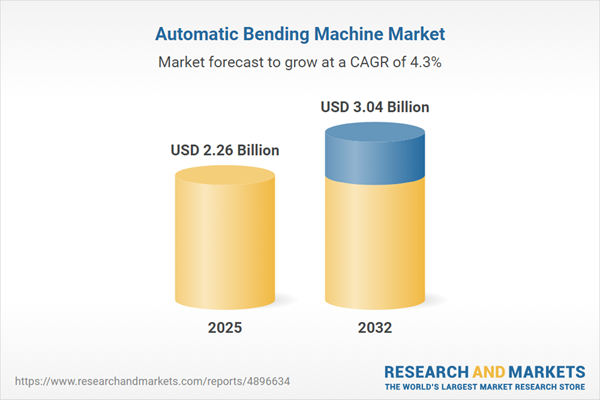Speak directly to the analyst to clarify any post sales queries you may have.
The automatic bending machine market is advancing as manufacturing companies seek efficient, reliable solutions that adapt to evolving industry requirements. Senior executives recognize the value of technologies that deliver operational consistency, support regulatory compliance, and foster adaptability in global production environments.
Market Snapshot: Trends Shaping the Automatic Bending Machine Market
The automatic bending machine market is demonstrating steady expansion, moving from USD 2.17 billion in 2024 to USD 2.26 billion in 2025, and is projected to reach USD 3.04 billion by 2032, corresponding to a CAGR of 4.30%. Market development is closely aligned with rising investments in automated manufacturing infrastructure and advanced digital controls, while adoption broadens within sectors such as automotive, aerospace, construction, consumer goods, and shipbuilding. Increased demand for efficiency, rapid production line adaptation, and continuous quality improvement is fostering a climate where regulatory shifts and sustainability imperatives continue to impact organizational strategies and product innovation.
Scope & Segmentation of the Automatic Bending Machine Market
- End Use Industry: Aerospace demands high precision and regulatory compliance; Automotive incorporates both OEM and aftermarket supply chains; Construction prioritizes volume and reliability; Consumer Goods require flexible production; Shipbuilding leverages scalable solutions.
- Technology: CNC configurations (two-axis, three-axis, four-axis and above) ensure adaptable manufacturing; Electric aligns with sustainability objectives; Hydraulic and Mechanical methods provide consistent performance; Servo Electric enhances precision in specialized environments.
- Bending Capacity: Up to 100 tons addresses lighter fabrication; 101 to 300 tons serves core industrial needs; Above 300 tons meets requirements for heavy manufacturing projects.
- Automation Level: Standalone systems offer modular expansion; integrated line solutions—including conveyor coordination and robotic cell deployment—facilitate streamlined end-to-end process automation.
- Regions: Americas benefit from established bases in the United States, Canada, and Latin America; Europe, Middle East & Africa address diverse regulatory climates and robust technology investment; Asia-Pacific adapts to rapid industrialization across China, India, and Southeast Asia, shaping distinct market entry and development strategies.
Key Takeaways for Senior Decision-Makers
- Adoption of automation and digital controls offers increased flexibility, enabling companies to respond rapidly to shifting production requirements and customer expectations across diverse applications.
- Energy efficiency and modular process improvements are guiding manufacturers toward sustainable designs while ensuring profitability and regulatory compliance remain central priorities.
- Industrial IoT adoption enhances operational visibility, enabling predictive maintenance, remote asset monitoring, and early identification of process issues to minimize production disruptions.
- Collaborative partnerships among equipment suppliers, robotics specialists, and software providers support full-system integration and expedite the commissioning process across manufacturing lines.
- Changing procurement models like equipment leasing and flexible sourcing help organizations mitigate risks from supply chain fluctuations and evolving trade policies.
- Market strategies must be tailored to specific regional conditions, as established economies and emerging markets require differentiated operational and partnership approaches to effectively drive growth.
Tariff Impact: Navigating 2025 Trade Pressures
Recent tariff changes affecting steel components and European control units within the United States have raised complexity for buyers and sellers in the automatic bending machine market. Organizations are addressing these challenges by diversifying supply sources and exploring nearshoring and regional production. Companies are also utilizing equipment leasing and alternative financing to offset increased costs related to duties. Flexibility in procurement and logistics enables market participants to effectively adapt and reduce exposure to ongoing trade uncertainties.
Methodology & Data Sources
This report applies a robust mixed-methods approach, combining primary interviews with original equipment manufacturer executives, plant engineers, and automation specialists, alongside in-depth secondary research and proprietary analytics. Both qualitative and quantitative methods, including scenario-based analysis and topic categorization, underlie the actionable insights offered for executive decision-making.
Why This Report Matters
- Offers an in-depth perspective on evolving market conditions and technology advancements, giving stakeholders the insights needed for forward-looking planning and operational alignment.
- Delivers clear guidance for navigating regulatory shifts, addressing supply chain dynamics, and integrating sustainability into organizational strategy for the automatic bending machine sector.
- Highlights collaboration and growth opportunities, empowering leaders to adapt business models and partnerships for competitive advantage in a dynamic manufacturing landscape.
Conclusion
This analysis enables senior leaders to make informed strategic choices as the automatic bending machine market evolves. Applied insights strengthen organizational resilience and optimize growth in an increasingly complex global manufacturing environment.
Additional Product Information:
- Purchase of this report includes 1 year online access with quarterly updates.
- This report can be updated on request. Please contact our Customer Experience team using the Ask a Question widget on our website.
Table of Contents
3. Executive Summary
4. Market Overview
7. Cumulative Impact of Artificial Intelligence 2025
List of Figures
Samples

LOADING...
Companies Mentioned
The key companies profiled in this Automatic Bending Machine market report include:- Amada Co., Ltd.
- TRUMPF GmbH + Co. KG
- Bystronic Laser AG
- LVD Company nv
- Salvagnini Italia S.p.A.
- Murata Machinery, Ltd.
- Komatsu Industries Corp.
- Prima Industrie S.p.A.
- Ermaksan Makina Sanayi ve Ticaret A.Ş.
- Dener Makina Sanayi ve Ticaret A.Ş.
Table Information
| Report Attribute | Details |
|---|---|
| No. of Pages | 198 |
| Published | October 2025 |
| Forecast Period | 2025 - 2032 |
| Estimated Market Value ( USD | $ 2.26 Billion |
| Forecasted Market Value ( USD | $ 3.04 Billion |
| Compound Annual Growth Rate | 4.3% |
| Regions Covered | Global |
| No. of Companies Mentioned | 11 |









